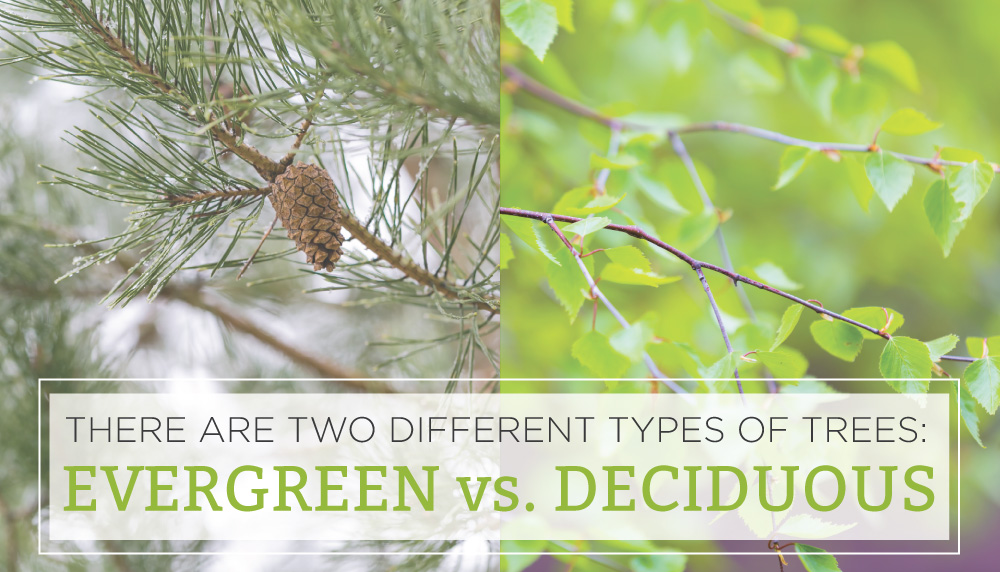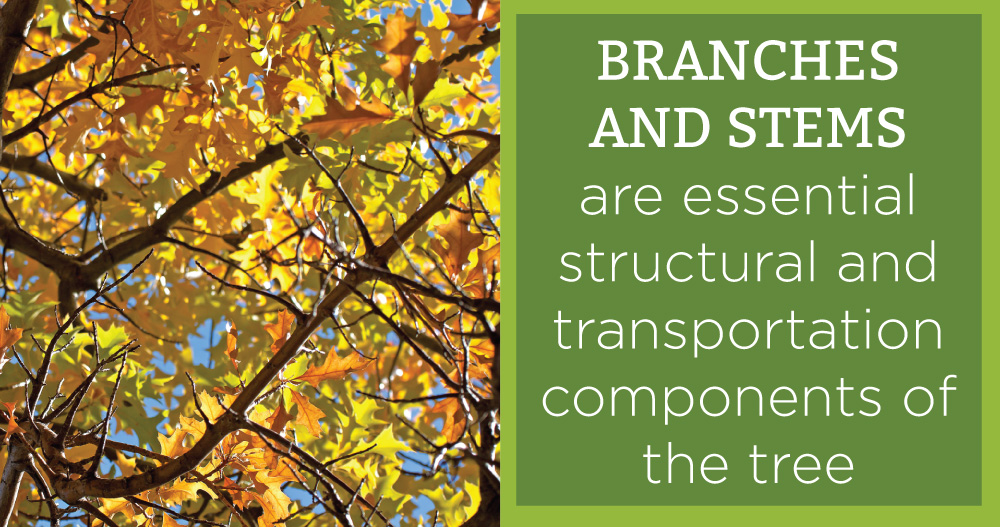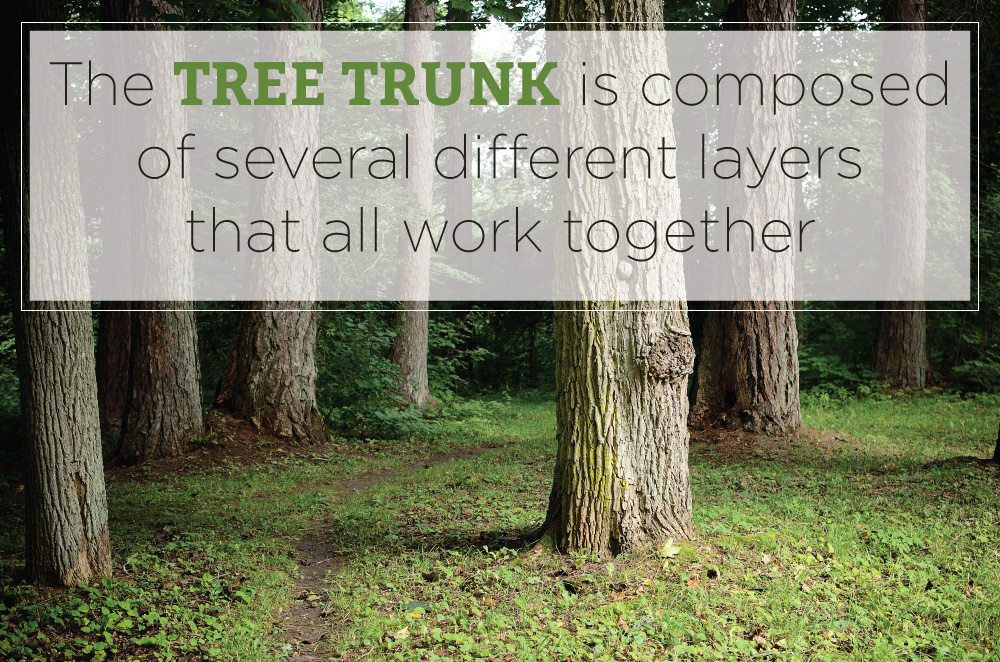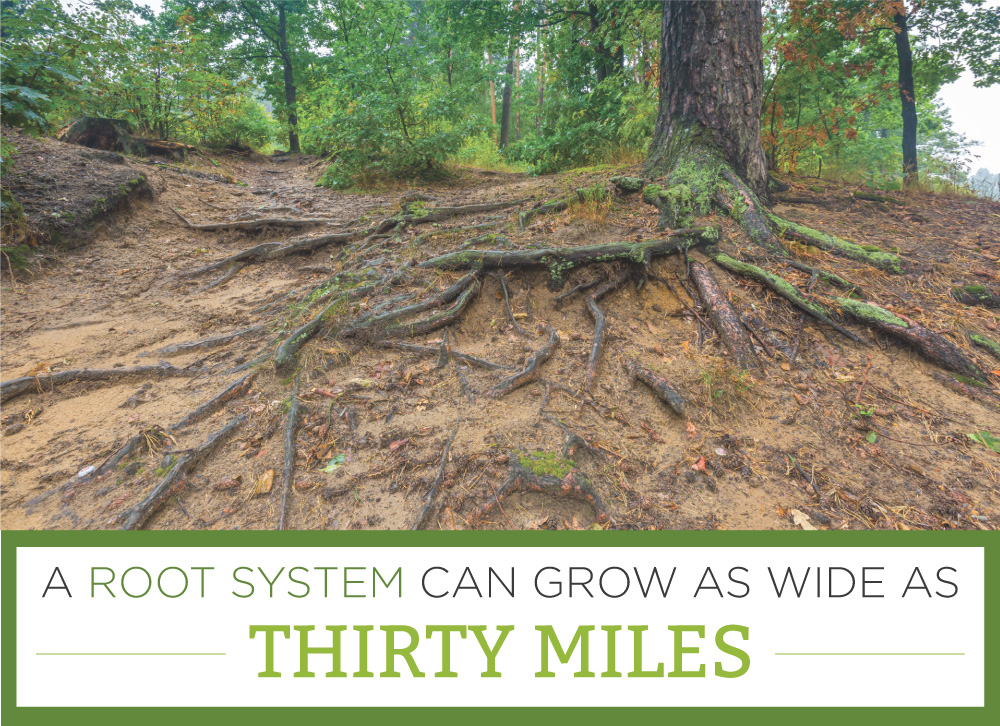
Learn the Parts of a Tree
For people, trees serve many purposes. They produce fresh oxygen, provide us with food, help us produce fuel and supply us with construction materials. Humans also benefit from the emotional support of trees as entire tourism and wellness industries promote ecological retreats. Trees also help to keep our climate cool while offering shade, shelter and habitats for forest-dwelling animals and insects.
However, despite how prolific and iconic trees are and what a staple they are in daily life, the average person knows very little about the inner workings of a tree. Understanding not only the magnificent service trees provide to humans, but having an appreciation for the anatomy of a tree is critical in knowing how to manage and care for trees on your property.
In this guide to understanding basic tree anatomy, we’ll review what makes a tree a tree, the broad types of trees, the different parts of a tree and how they each work together to support the tree itself and our environment.
By the Numbers
First, lets take a look at some tree stats. There are an estimated three trillion trees on the planet covering roughly 30% of the Earth’s surface. That means trees outnumber humans nearly 400 to one.
Additionally, scientists have discovered over 60,000 different species of trees, and, of course, all of these 60,000+ species are an integral and crucial part of the environment.
What Constitutes a Tree?
Because there are so many different types of plants, it’s important to know what constitutes a tree as opposed to other, similar vegetative types, like shrubs. Though there are thousands of species of trees, they all have a few factors in common, which identify them as trees. Here are the different factors that make a tree a tree:
- Size: To be considered a tree, the plant must be at least 15 feet high when fully mature.
- Stem: Trees have one single woody stem that is the predominant support of the plant’s structure. This is known as its trunk.
- Diameter: A tree’s stem or trunk has a minimum 3-inch diameter at 4.5 feet above ground. The stem then has a full crown of foliage at the top.
- Perennial: Unlike certain shrubs or other plants, trees are present-year round.
Tree Types
There are countless types of trees each within their own family (genus) of tree. But in broad terms, there are two types of trees: evergreen and deciduous.

1. Evergreen
Evergreen trees are those that keep their foliage year-round. Evergreens have naturally adapted so that they do not need to shed their foliage during the colder months to conserve water or prevent water loss. Generally, evergreens are conifer trees, which have needle-like foliage, but some evergreen trees may instead have flat, broad leaves. Evergreen trees are also considered softwood.
Evergreen trees typically grow in colder climates, with hard or poor soil. Examples of evergreen trees include:
- Pine
- Hemlock
- Fir
- Cypress
- Spruce
- Redwood
- Juniper
2. Deciduous
The other broad type of tree is called a deciduous tree. These are the hardwoods. Unlike evergreens, which maintain their foliage year-round, deciduous trees shed their leaves during winter months. Deciduous trees drop their foliage as a way to avoid having to use water and nutrients to nourish their leaves in harsh conditions. When deciduous trees drop their leaves, their foliage rots and nourishes the soil to provide food for other plants and animal life.
Deciduous trees are often referred to as broadleaf trees, meaning their foliage is broader than the evergreen needles. Examples of deciduous trees include:
- Birch
- Mahogany
- Oak
- Maple
- Hickory
- Elm
- Aspen
Different Tree Parts
Now that we have a good understanding of the unique qualities that differentiate trees from other plants, as well as the broad classifications of trees, we can now look at the main parts of a tree.
Trees are vascular plants, meaning they use a system of vessels to transport nutrients and water. This transport system continuously delivers these essential elements to the rest of the plant. A tree’s transport system consists of multiple organs, each serving a critical and unique role in this transport system. Though there are countless components to a tree all dependent on the species, a tree’s basic anatomy can be broken down into these different tree parts:
- Leaves
- Branches and stems
- Trunk
- Roots
Each part of the tree serves multiple, critical functions, and the relationship between a tree’s parts is symbiotic —one part can’t work without the others. Additionally, the different tree parts also serve a function not only for the tree’s benefit, but for the benefit of the entire ecosystem in which it resides.
Here are the different tree parts and the functions each one of them serves:
1. Leaves

Leaves belong to the crown of the tree, which is the top part of the tree that grows out of the trunk and includes the branches and stems. While each tree has its unique biological makeup, the average tree consists of 5% leaves. The remaining 95% comprises the trunk, roots, branches and stems.
Description: When you think of tree leaves, you usually picture green, oblong or oval shaped foliage. The truth is that trees come in endless shapes, sizes and color shades. Some leaves are broad, while others are pointed needles. Some trees produce a combination of smaller sized leaves called leaflets, which together make up one leaf. All leaves contain chloroplasts, which house a substance called chlorophyll. Chlorophyll is a family of substances found in all plants and algae, and it’s responsible for giving leaves their vibrant or rich green pigments.
Functions: Leaves serve multiple functions for a tree’s ability to grow and thrive. The most well-known function of tree leaves is to facilitate the process of photosynthesis. This process occurs when the leaves use the energy from the sun to create fuel for the tree.
During photosynthesis, the leaves take the carbon dioxide from the atmosphere and the water taken up from the surrounding soil and convert it into oxygen and sugar — carbohydrates. The sunlight is the energy that catalyzes this process. The result of photosynthesis is that the tree uses the sugar for food or stores it in its roots, trunk and branches. This is so with evergreens, which use fuel year-round. Then, the freshly converted oxygen gets released into the atmosphere benefiting all other living beings around, including humans.
In addition to photosynthesis, leaves also offer shade, reduce wind force, keep the air cool and filter out dust and other particles. Leaves also act as a buffer for heavy rain drops by minimizing their impact on the ground below. Finally, leaves allow for water evaporation and runoff through their “drip tips.” This helps prevent the leaf from rotting.
2. Branches and Stems

Like leaves, branches and stems also belong to the crown of the tree. Branches and stems are essential structural and transportation components of the tree operating between the trunk and the leaves. Roughly 15% of a tree consists of its branches and stems.
Description: All trees are unique, and so are their branch and stem systems. Branches are the thicker arms that grow directly from the trunk. Stems and twigs are the smaller fingers that grow from the branches, and the leaves grow from the stems and twigs.
Depending on the tree, some branches may grow taller than the branches of other nearby trees to dominate over them. This is called a dominant tree, and it tries to obtain as much sunlight as possible. However, other trees may have branches that grow outward as opposed to upward. These codominant trees share space with other trees around it.
Many trees have branches that shoot straight out of the trunk, followed by an intricate system of stems or twigs. Other trees have branches that grow in interesting directions and may even swirl or twist to gain access to more sunlight.
Functions: Branches and stems have several functions. They play the role of structural support for the leaves, fruits and flowers that the tree produces. They are also the vessels that carry water from the soil to the leaves, and the food from the leaves to the rest of the tree.
Additionally, branches store unused food that the tree will then use later on, especially during dormant periods when the temperatures drop.
3. Trunk

The trunk of the tree, also sometimes called the main stem, makes up the majority of the tree at 60%. A tree’s trunk is one of its primary organs, helping it reach the heights it needs to find sunlight. Though it may seem straightforward, the biology of a tree trunk is quite complex.
Description: Tree trunks are known as the thick stem that supports the tree, and they are covered in a protective bark layer that can be peeled off to the expose the layers beneath. Tree trunks, like their leaves, come in all different shapes, sizes, colors and textures. Depending on the tree, the trunk may be wider at the ground and narrow at the top. Some trees have thinner trunks that grow tall and slender.
The tree trunk is a continuously growing organ intricately composed of several layers. If you’ve ever looked at a tree stump, you know that the trunk consists of dozens of rings, but you might not know what all these rings mean. Here are the layers that make up a tree’s trunk and how they work together:
- Bark: The bark is the outermost layer of a tree’s trunk. It’s designed to protect the tree from various diseases, growths and other threats. The bark has an outer and inner layer (phloem), making up two of the five tree trunk layers. Depending on the tree, bark can be smooth, rough or even prickly. Bark also comes in different patterns such as stripes, spots, dashes or jigsaw.
- Cambium: The cambium layer is the part of the tree trunk that is living and growing. Every year, the cambium layer of a tree trunk grows, which expands the tree’s diameter. The cambium continues to grow because of the nutrients and hormones it receives from the bark, which come from the leaves. These hormones, or auxins, stimulate the trunk’s growth, which adds another ring. Sapwood: Trees have an inner layer called sapwood (xylem), which is responsible for moving water up the trunk and out to the leaves. As the tree ages, new layers of sapwood are born. The older layers of sapwood die and become the innermost layer called heartwood.
- Heartwood: The heartwood section of a tree trunk is composed of layers of sapwood that have died. The heartwood is the oldest part of the trunk and the darkest in color. Though dead, it remains incredibly strong to continue to support the entire framework of the tree.
Functions: A tree’s trunk has two primary functions. The first job of a tree trunk is to give it its size and shape. It’s the pillar of strength that provides the tree with the structural support for its branches and leaves to grow upward and outward.
The second job of a tree trunk is to act as the hub of the transport system. The trunk facilitates the movement of water and minerals up from the roots in the soil to the branches, stems and eventually to the leaves. The trunk also facilitates the movement of the sugar down from the leaves, stems and branches to the roots.
4. Roots

Roots are likely the part of the tree that the average person is the least familiar with. That’s because these complex systems live below the soil and aren’t visible. But roots are a critical factor in understanding tree anatomy information. A tree’s roots are its anchor and make up 20% of its biology. They grow to a width that’s up to twice as wide as the tree’s crown. In large trees, a root system can grow as wide as 30 miles.
Description: Roots grow underneath the ground from the tree’s trunk and spread laterally through the soil. Most of a tree’s root system is only 12 to 18 inches below the soil. How deep a root system grows greatly depends on the type of tree and the composition of the soil in which it grows.
Each root has its own sets of stems that grow into smaller roots. Roots are also covered in root hairs, which help to increase root surface area and improve water and mineral uptake. It’s also common for roots to have colonies of fungi growing on them. These fungi colonies are called mycorrhizae, and they’re beneficial to the tree’s health.
Functions: Like other main parts of a tree, the roots also serve multiple purposes. Roots help anchor the tree to the ground, which is important as the tree ages and faces harsh elements that threaten its stability. In addition to helping the tree with its structure and growth, roots facilitate oxygen, water and mineral uptake, and they also absorb oxygen, water and minerals from the ground. These absorbing roots then feed into conducting roots, which transport the water and minerals inward toward the trunk.
Tree Management and Care
These basic parts of a tree will help give you a better understanding of the intricacies involved in a tree’s design. Though trees are self-sufficient organisms that have an impressive internal system for survival, they still need care and management when growing on private properties. Just as there is much to know about the anatomy of a tree, there’s also lots to know about how to care for them properly.
Professional arborists have the skills to recognize damaged and diseased trees and limbs, to diagnose potential problems and to apply the right solutions that protect both the tree and your property. To keep your backyard trees healthy and to prevent potential hazards during harsh weather, turn to professional tree management experts like Richard’s Tree Service. Contact us today for our tree care and removal services.
If it is an emergency please call us immediately at 703-354-3667.
Use this form to schedule a FREE estimate. After submitting your form, our team will contact you to set up this appointment.
